There’s nowhere quite like Venice. The floating city has captured the imaginations of artists, explorers and lovers for centuries. But with its labyrinth of narrow streets and seemingly endless cultural and gastronomic offerings, it can be a tad overwhelming.
Luckily, our 48-hour guide to La Serenissima hits all the island’s sweetest spots (with plenty of insider tips), so you can spend less time planning, and more time dreaming of canalside cicchetti and sundowner spritzes.
FRIDAY: EVENING
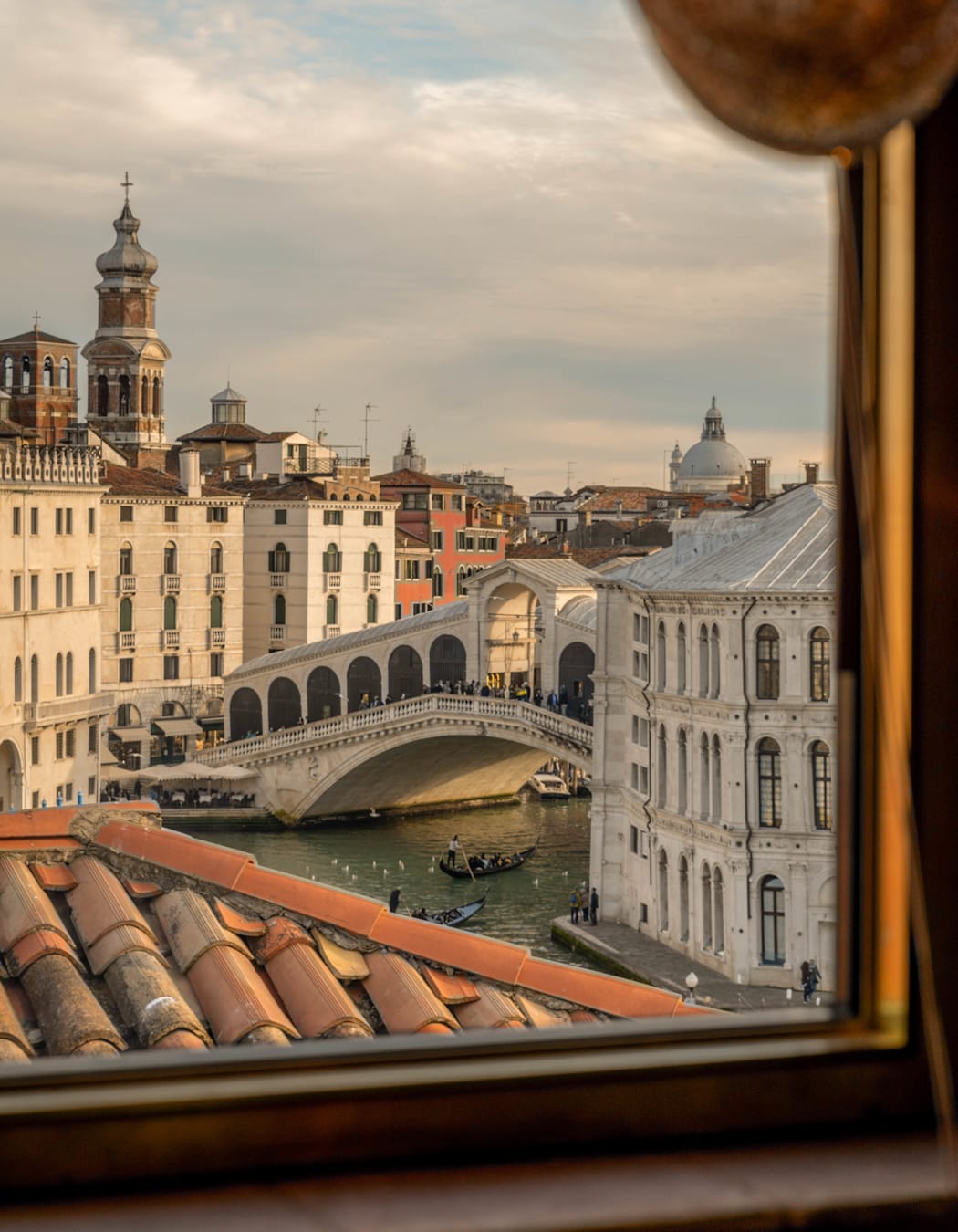
View from Venice Venice hotel
First things first; get to the island. From Marco Polo Airport, the quickest way to do that is by boat. Downstairs from departures, you’ll find stops for private water taxis and the Alilaguna boat, the public airport shuttle. Plan it right and you’ll arrive in time for the iconic – though somewhat secret – happy hour (between 5pm and 7pm) at Taverna al Remer, a vaulted brick joint tucked away behind an ivy-strewn portico in Cannaregio. There’s live music most days and a picturesque cortile to spill into on balmy evenings. When sufficiently spritz’d, the Venice Venice hotel is just a shuffle away. Check in and fuel up on plates of pea risotto, Sant’Erasmo parmigiana and fresh truffle pasta, before hitting their Grand Canal-side terrace for a nightcap, where blood-red americanos pair nicely with scarlet Rialto sunsets.
SATURDAY: MORNING
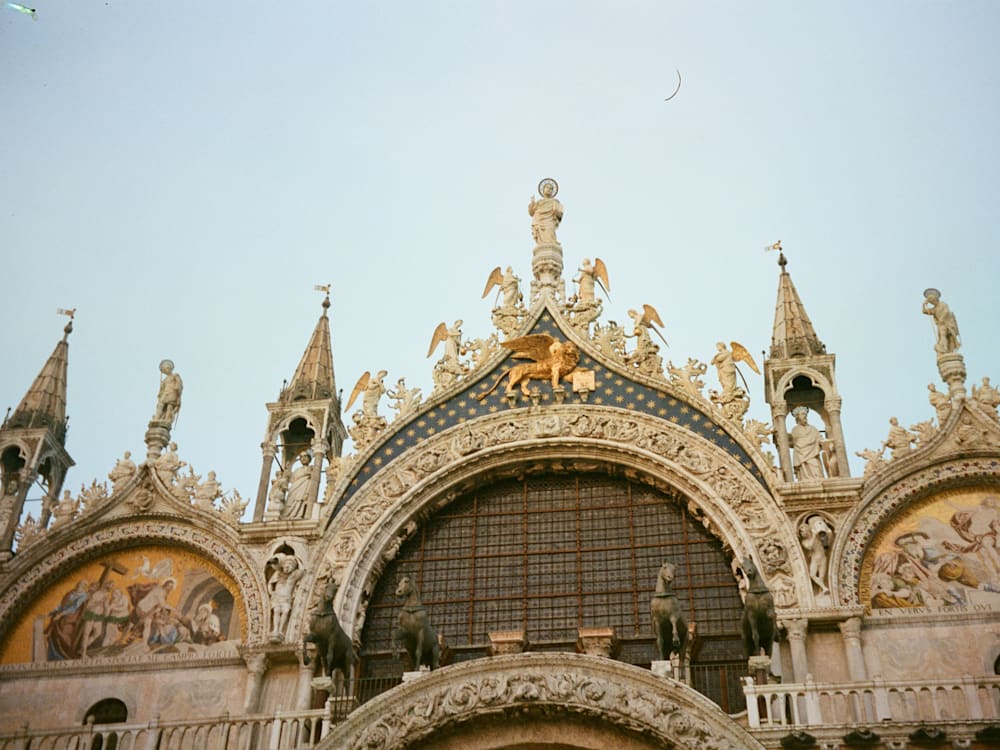
Morning sun illuminating the artworks (many by very famous names indeed) in your room at the Venice Venice is a fitting start to a day of gallery-hopping and art-gazing. But first, there’s breakfast at the hotel’s aptly-named M’Art restaurant, where a kitsch-y cart service of Moka coffee and sugary fried pastries is followed up with eggs Benedict, syrup-slathered waffles and wild-berry granola.
In the name of efficiency, start your art tour with the city’s largest masterpieces; Palazzo Ducale and San Marco’s Basilica. It may be touristy, but trust us when we tell you why people flock here: gasp-inducing gilded interiors, a history so full of power-grabbing drama it makes Succession seem like Sesame Street, and views from the Campanile that are simply unmatched. Get there early to beat the tourist hordes; though it may seem unintuitive, it’s best not to book online, as those queues are often longer.
One ticket will grant you access to the Correr and National Archaeological museums as well as the Biblioteca Nazionale Marciana – all worthy of a visit – as is Negozio Olivetti, a typewriter-store-turned-museum designed by Venezia’s prodigal son, Carlo Scarpa. Today, it stands as an ode to Modernist design with a floating stone staircase, colourful glass-tiled floors, sculptural windows and elegant Aurisina marble and rosewood accents. Complete your tour of Piazza San Marco with a standing spritz at Ai Do Leoni, a tiny bar to the side of the basilica whose interiors – and prices – are more Italo disco than Italian Baroque.
SATURDAY: AFTERNOON
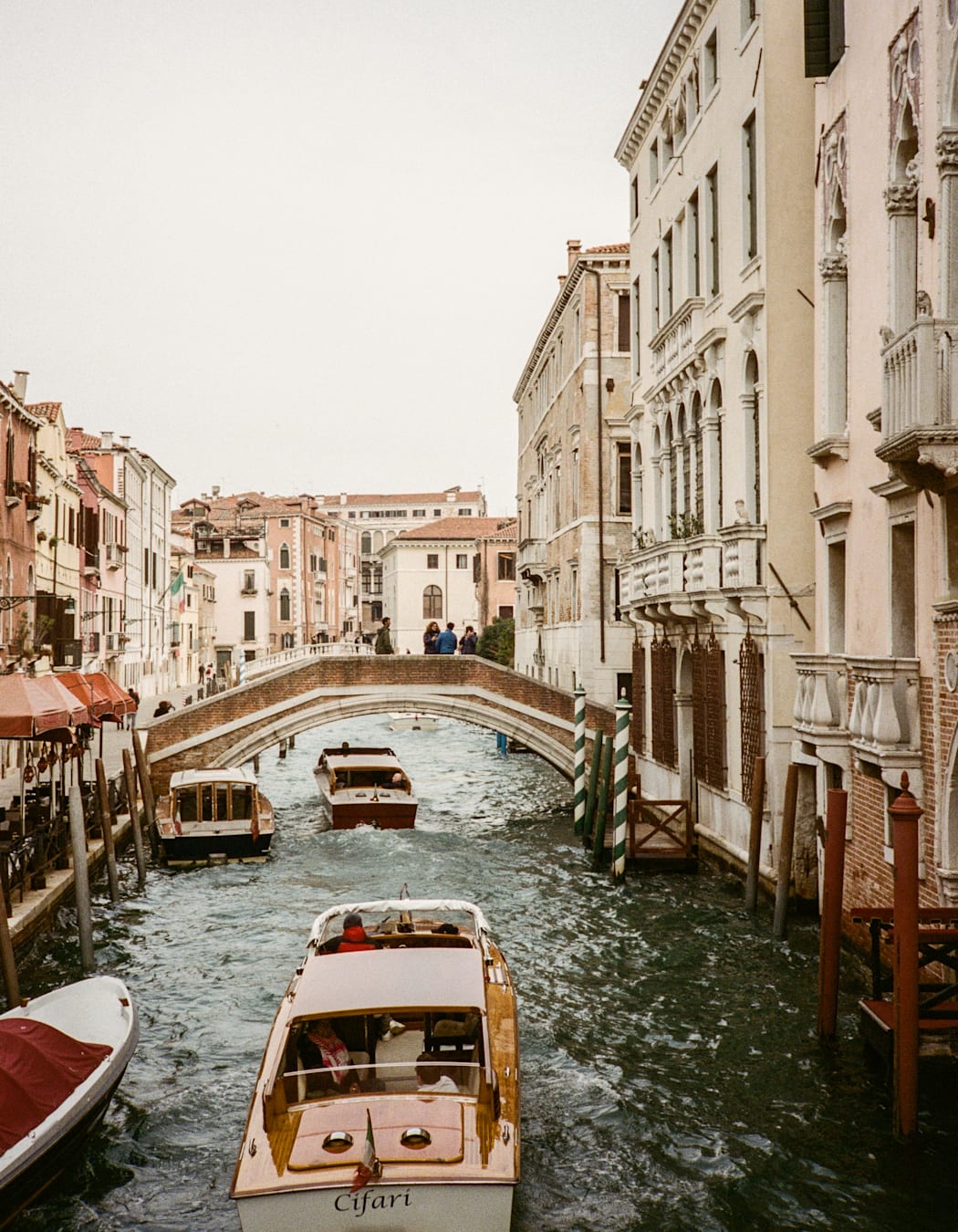
Heading north, cross the Accademia bridge and continue your culture-crawl at Galleria dell’Accademia, home to the largest collection of pre-19th-century Venetian paintings in the world. Here, you can get up close and personal with Tintoretto, Bellini and Titian masterpieces, as well as Giorgione’s mysterious La Tempesta, one of the world’s first landscapes whose meaning is still hotly debated by scholars. Next, take a short stroll to the Peggy Guggenheim Collection, the former home of the gallery’s namesake socialite, who Gore Vidal described as ‘the last of Henry James’s transatlantic heroines, Daisy Miller with rather more balls.’ and whose patronage forged the landscape of 20th-century art. Learn about Peggy’s fascinating life (which was rather decadent, by all accounts – when construction workers dived below the building’s balcony to survey the stilts, they found a graveyard of empty Champagne bottles covering the canal bed…) in the company of Max Ernst, Dali, Picasso and Kandinsky.
After, take the long route to contemporary art outpost, Fondazione Prada (owned by fashion’s beloved Miuccia), stopping along the way at the Gothic Basilica Santa Maria dei Frari to marvel at its Titian altarpiece and Bellini triptych; Venice’s oldest bookshop Libreria Toletta, which has been charming literary lovers for over 90 years; Pasticceria Tonolo, the island’s most renowned bakery, famous for its sugar-dusted speciality frittelle; and Caffe Rosso in the lively piazza of Campo Santa Margherita, where you’ll encounter a eclectic crowd of Iuav University fashion students and newspaper-wielding older gents.
SATURDAY: EVENING
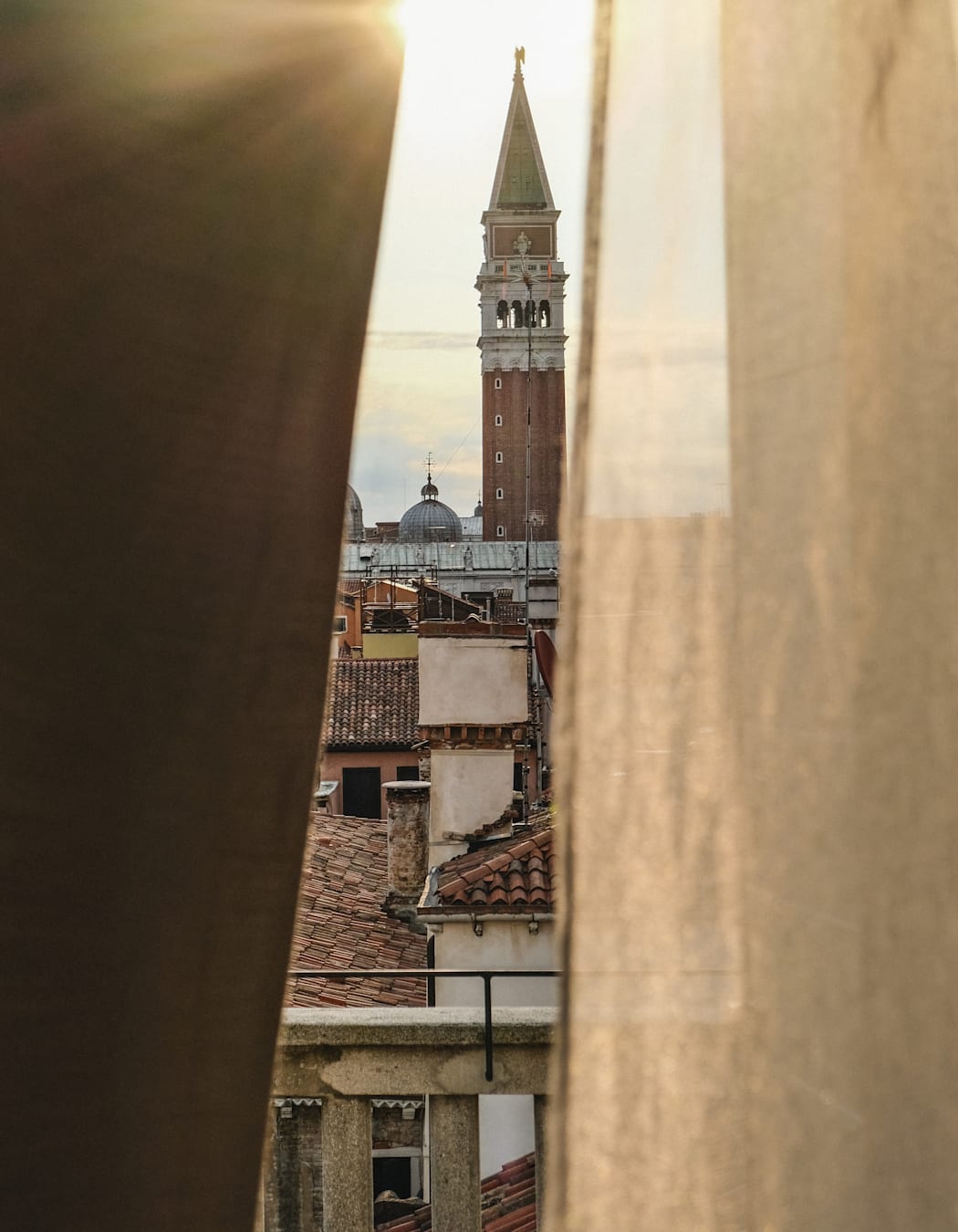
View from Nolinski Venezia
Change into gladder rags and make your way to Nolinski Venezia for a pre-dinner aperitivo. The sultry library bar here has burgundy-velvet seating, a 4,000-strong collection of rare books and a Simon Buret ceiling fresco depicting a dreamy, underwater world. For dinner, book a table at Pietra Rossa in Castello, named after a single red stone (the pietra rossa) in the pavement of the adjacent portico. According to ancient legend, this marks the spot where the plague was halted as it ravaged the city in 1630, sparing the residents of Corte Nova. The portico itself is one of the most impressive in the city, with an ornate ceiling and two 17th-century paintings, but the stone is said to bring bad luck, so do as the locals do and walk around it.
Conversely, the restaurant bears favourable fortune. The newest project of charismatic Venetian chef Andrea Lorenzon (formerly of the sought-after restaurant Covino), each dish is an ode to his home city – veggies from Sant’Erasmo, fish from the lagoon, and meats from Veneto mainland – fashioned using ancestral cooking methods. Opt for the surprise ‘fà-ti’ menu (‘it’s up to you’ in Venetian) of three courses paired with interesting wines. Be sure to start with a glass of Vino Amico, a Col Fondo wine made exclusively for the restaurant. Finish off with an artisanal Amaro liqueur at Campo Santa Maria Formosa’s trendiest wine bar, Ozio.
SUNDAY: MORNING
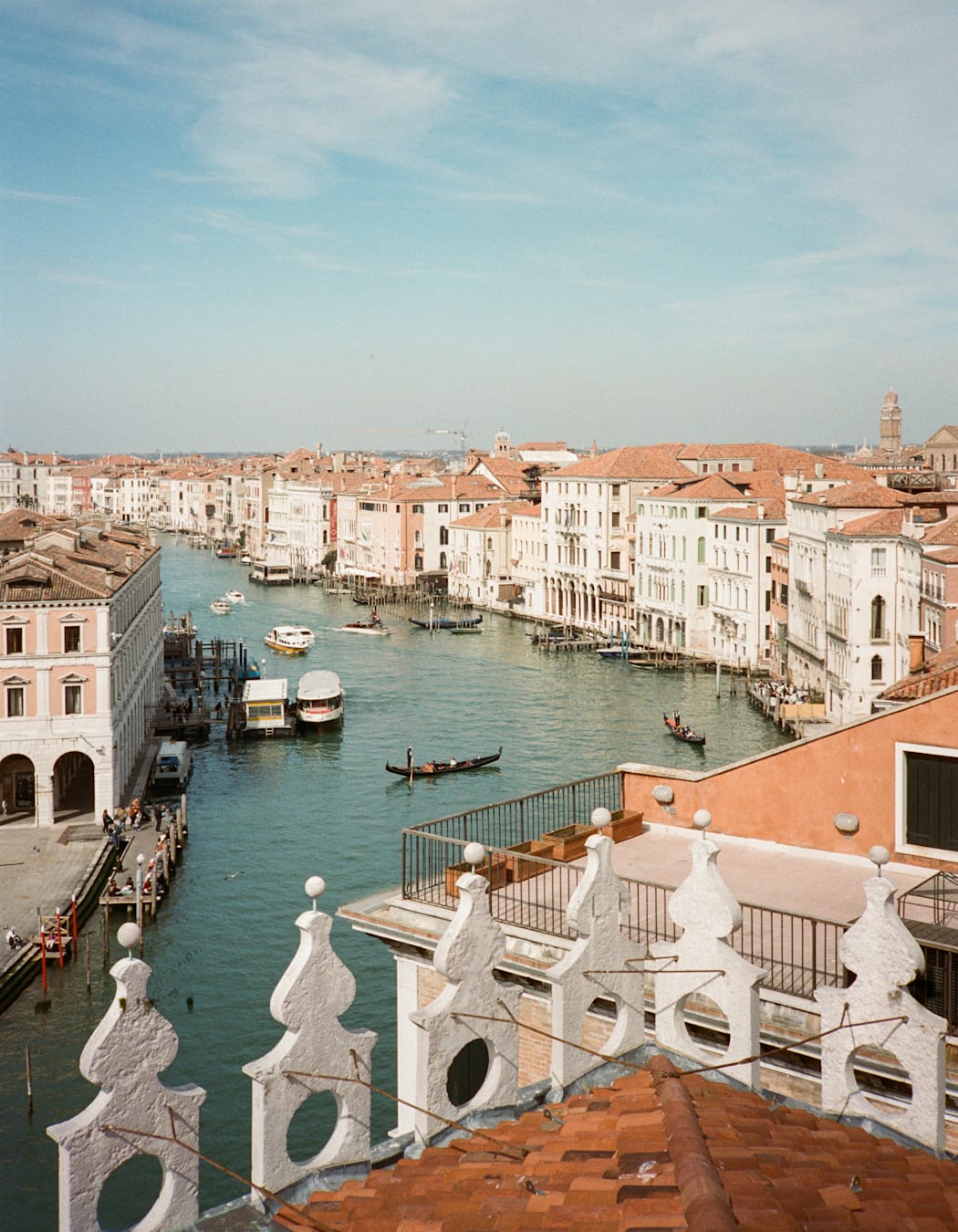
Fondaco dei Tedeschi rooftop
Start your day bright and early at Rialto fish market. While proceedings are a bit more genteel than those in the South, the setting – with its resplendent arches framing the Grand Canal – makes it worth the early start. Stop for an oyster at Wenice then shuffle over to All’Arco for a Venetian-style breakfast; a glass of white wine and a classic porchetta panino made by father-and-son duo Francesco and Matteo Pinto. If you happen to be there in November, ask for the castradina (smoked-and-seasoned mutton loaded with cabbage), a hyper-local specialty made at this time each year.
Make Fondaco dei Tedeschi your next stop. Once used as the headquarters of German merchants, then as Poste Italiane offices, this 16th-century building – impressively made-over by architect Rem Koolhaas’s studio OMA – now functions as a luxury department store. On the top floor, you’ll find a small exhibition space with a rotating programme of contemporary art shows and a rooftop terrace with incredible views over the Rialto Bridge and canal below. Access is ticketed to limit overcrowding, but entry is free and available to book online.
While taking your plastic for a spin, cross Campo San Bortolomio to browse the Venezia FC outlet, which feels more like a high-fashion concept store with a sporting slant. It’s also a case study in art direction: by 2015, the club had gone bankrupt three times and there were questions of how viable football was in such a peculiar urban context. That’s when Ted Philipakos (now of Athens Kallithea) stepped in with a rebrand that has helped the club become one of the coolest in world football. Alongside the store’s chic shirts and scarves, you’ll see work by Venice-based street photographer Eric Scaggiante, who documented the triumph of the club’s return to Serie A in 2021 (and the tribulations of their downfall shortly after…)
SUNDAY: AFTERNOON
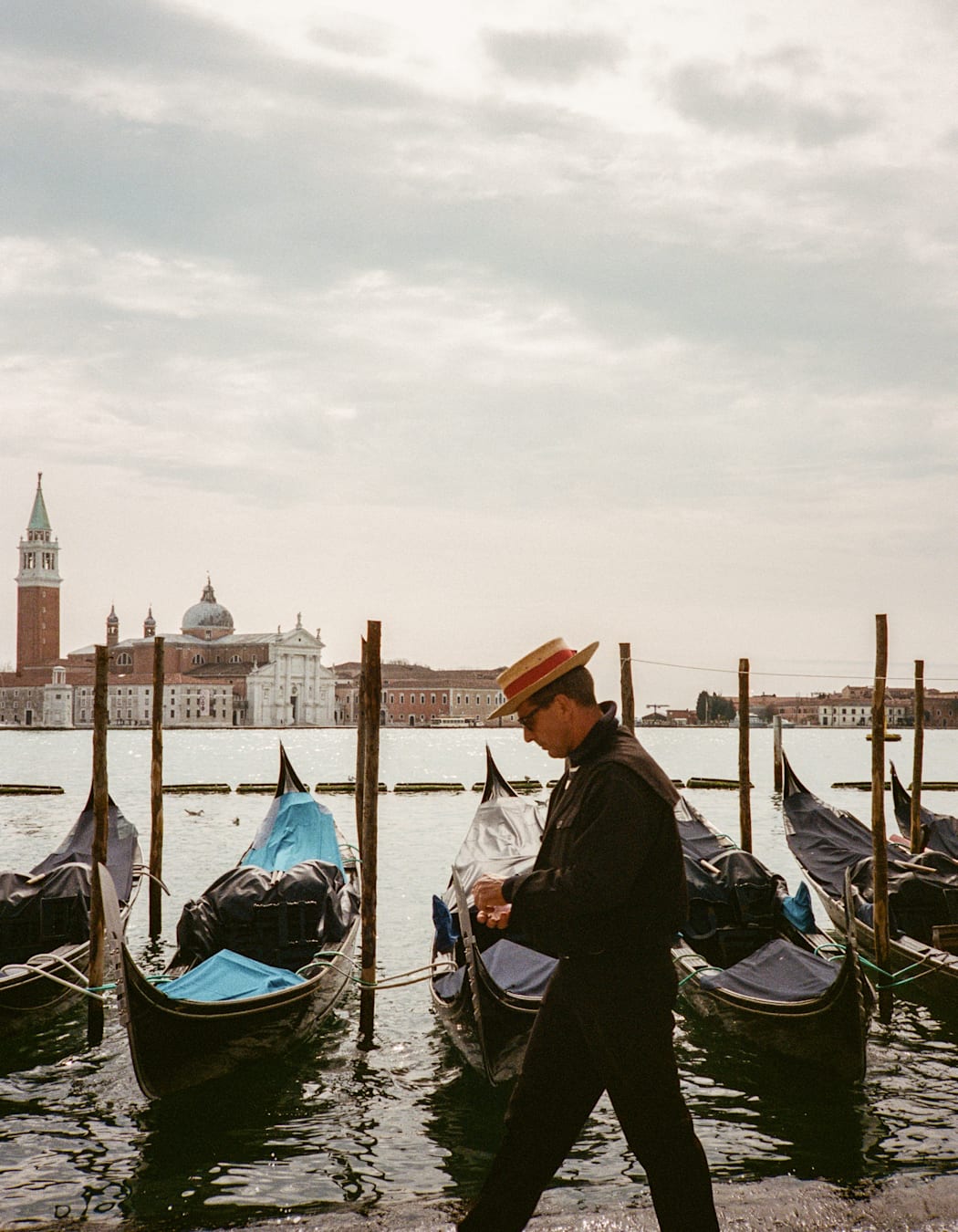
Take the vaporetto from San Zaccaria to Lido, the long slice of an island which separates the lagoon from the sea. If it’s sunny, book a hut on the beach and spend the afternoon topping up your tan. Otherwise, hire a bike and get exploring the island’s art nouveau architecture, bountiful nature, and high-glam hotspots. The island’s main strip, Gran Viale, is full of shops, bars and restaurants. Spritz up at Bar 9 (9 Via Lepanto) before heading on toward the sea. Take the Murazzi path south, passing the weathered Grand Hotel des Bains from Thomas Mann’s novella Death in Venice, the modernist Palazzo del Cinema (the site of the city’s annual film festival), the slick beach house of fashion designer Rick Owens – one of Lido’s most unlikely residents – and the quaint village of Malamocco. There’s not much to do in this low-key part of Lido, which is part of its draw, but the locals are keen to chat and feline-fanatics can visit the Gattille Di Malamocco, a cat sanctuary where Venetian strays are cared for. Continue on to Alberoni, the tail of the island immortalised in the poetry of Goethe and Byron, where you’ll find a protected nature reserve of pine forest, dune systems and wildlife.
Back at Santa Maria Elisabetta, Lido’s vaporetto terminal, take the number two boat to San Giorgio, home to a 16th-century Benedictine church and monastery-turned-cultural-centre. In the church, make a beeline for the two Tintoretto paintings which sit either side of the presbytery, before heading to Cini Foundation, a huge cultural complex with exhibitions, a Palladian cloister, library, 17th-century reading room, Jorge Luis Borges-inspired garden labyrinth and cypress woods. One of the most unusual offerings here are the Vatican Chapels – a collection of 10 woodland-surrounded avant-garde structures created by architects like Norman Foster, Eduardo Souto de Moura, and Smiljan Radic for the 2018 Venice Biennale. It’s worth noting that these are only accessible through booked tours, which run daily and last for just under two-hours.
SUNDAY: EVENING
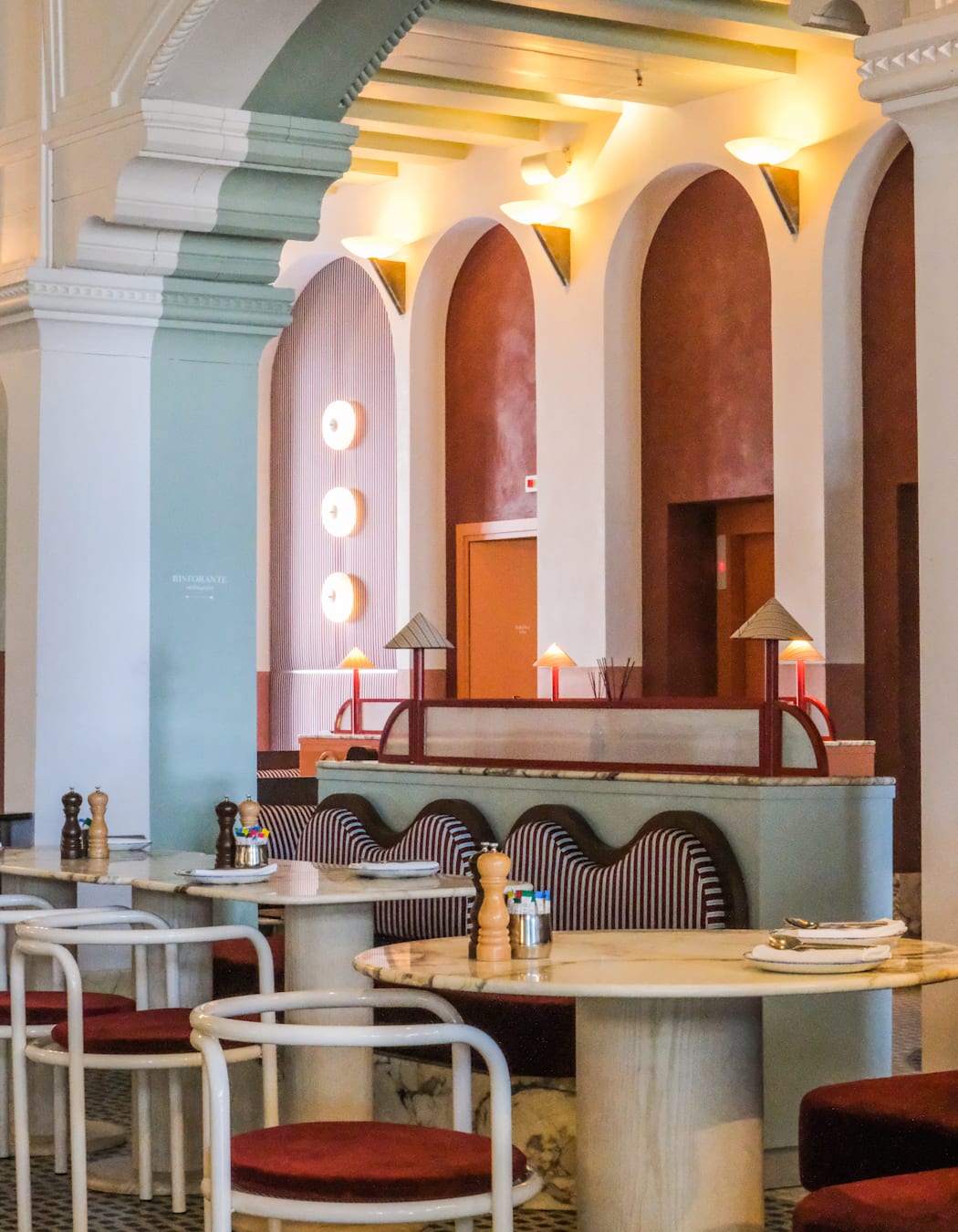
Il Palazzo Experimental
Jump back on the number two boat and head north to Zattere’s Al Squero, the perfect spot for pre-dinner aperitivo. Order a Select (the real Venetian spritz) and cicchetti to eat outside on the canal wall, overlooking a rustic gondola workshop. If eating cicchetti alfresco, make sure you keep a napkin over your plate – the seagulls here are notoriously brazen.
For dinner, book Il Palazzo Experimental’s Adriatica restaurant, where you can enjoy coastal cuisine from the length of the ‘boot’ amid Dorothée Meilichzon’s delightful interiors which blend seaside stripes, Scarpa-inspired terrazzo, candy hues and art deco details. And after filling-up on spaghetti alle vongole and buttermilk bucatini, a digestif is a must – after all, this is home to the Experimental Cocktail Club.
If your sweet tooth is tingling, neighbouring Gelateria Nico is a famed for its gianduiotto, a thick slab of chocolate-hazelnut gelato with a heap of whipped cream. Get one to go and make your way to Fondamenta Misericordia for a sunset giro d’ombre (wine crawl). This canal-side street, flanked with bacari, wine bars and pubs, is the nearest thing to nightlife you’ll find in Venice. On Mondays, Paradiso Perduto has live music from 9pm. Otherwise, our favourite bars include Vino Vero, Al Timon, and Mezzopieno. If you’re feeling adventurous, Row Venice do a bacaro-by-boat crawl. This all-female non-profit was founded by rowing champion Jane Caporal and seeks to preserve the island’s cultura acqua while levelling the playing field for women in rowing.
NEED TO KNOW
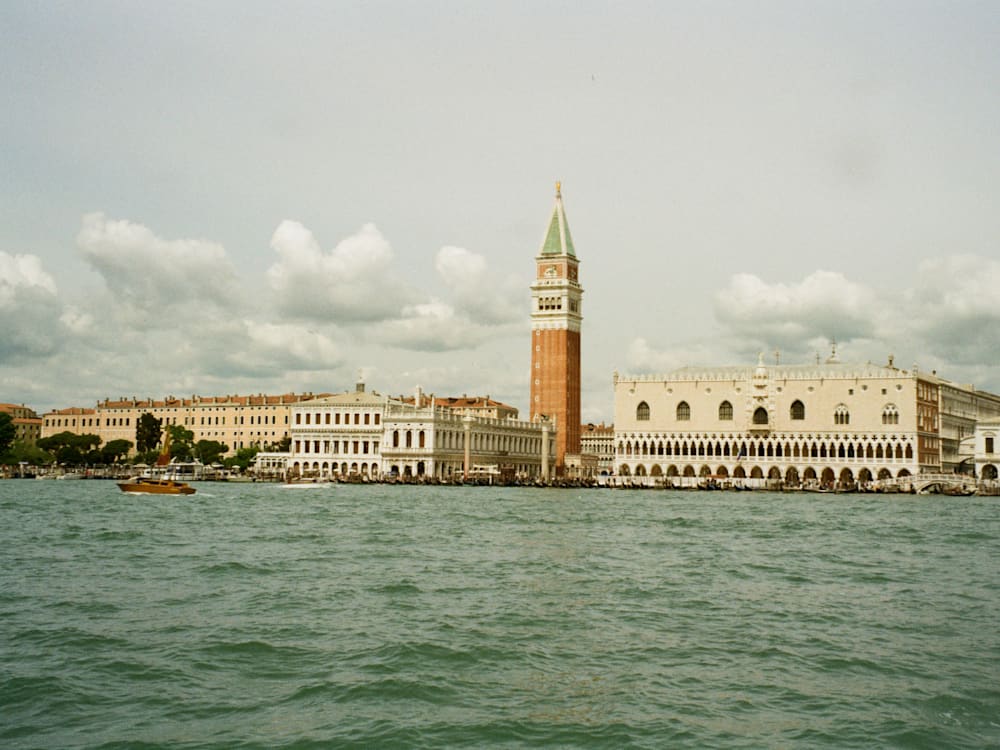
Flights Venice’s Marco Polo Airport is located near Tessera on the Venetian mainland, and takes around 15-25 minutes to reach by car, depending on traffic. If you’re staying North of the island – and travelling light – the best way to reach the city is via bus to Piazzale Roma (which can be found directly outside the terminal building) then across the Ponte della Costituzione and into the city on foot. Otherwise, take the Alilaguna water boat, or hire a private water taxi.
Transport Venice is easily walkable, but there’s alot to see, so the vaporetti (water buses) can help you pick up the pace. Tickets can be on the pricey side, so – if you’ll be using it a couple of times a day – opt for a two-day pass (around €35) rather than individual tickets. For extra convenience, download Che Bateo? (‘which boat?’), Venice’s answer to CityMapper. Trains from all over Italy can be caught from Santa Lucia train station at the top of the island, while buses and taxis can be hailed from across the bridge in Piazzale Roma.
When to go While summer has its perks – the fireworks of Redentore Festival, the star-studded Venice film festival, and livin’ la vida Lido on the island’s sandy beaches – it also has its pitfalls; namely, the crowds. Art lovers should arrive inspiring to catch the Venice Biennale in full swing (or the architecture version, depending on the year), and if you visit in November you’ll catch the very Venetian festival of Santa Maria Della Salute.
What to buy Fruilane, otherwise known as Gondolier slippers, grace everyone’s feet here – from dog-walking signoras to busy bellboys – nab yourself a pair of originals from Piedaterre, who’ve been pedalling them from their historic Rialto shop since 1952. For a killer outfit to accompany them Sangueblu has a curated selection of vintage designer pieces. Stock up on glass Venetian tiles at the historic Orsoni Venezia, or pop into Alessandro Merlin’s backstreet atelier which sells handcrafted ceramics with a homoerotic edge.
Good to know Essentially an express gondola service without the frills, the traghetti ferry people along the canal for a couple of euros each way. There are several crossings across the city, with Campo Santa Maria del Giglio to Salute and Rialto Market to Cà D’Oro among the most central. If you don’t want to splurge on a gondola (or spend 20 minutes walking to the nearest bridge) these are ideal, but make sure you have cash, ideally the right amount, to hand directly to the gondolieri.
Want to stay a little longer? See our collection of hotels in Venice
Additional photography by Stephanie Gavan and Michaela Watkinson

